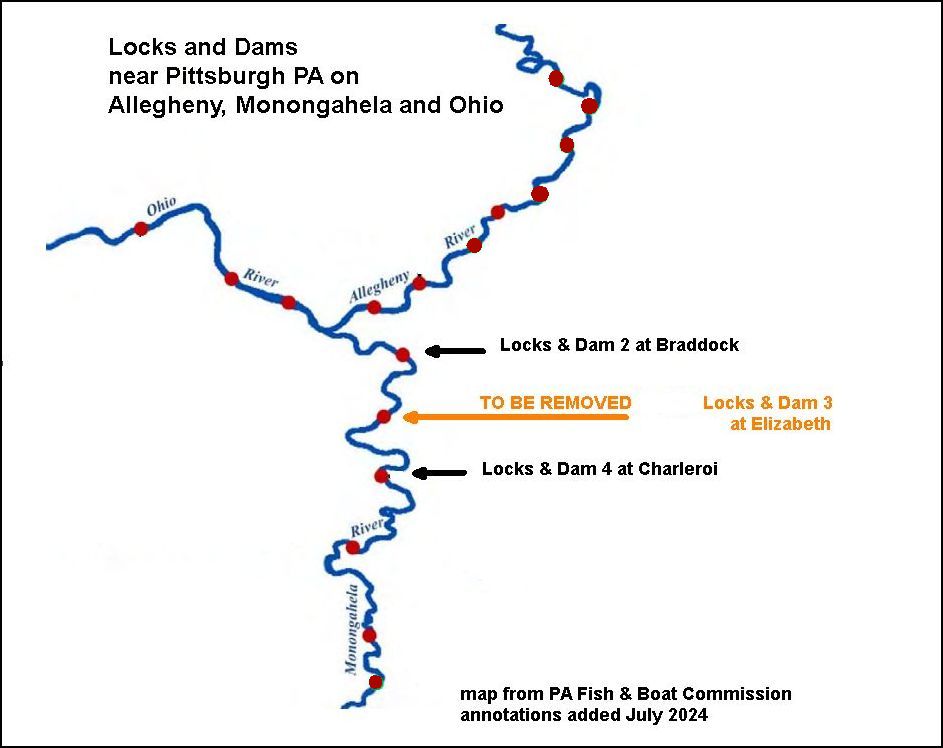
3 July 2024
What happens when a dam is removed from a river? We’re about to find out on the Monongahela River at Elizabeth, PA. On 10 July, weather and river permitting, the US Army Corp of Engineers (USACE) will begin removing Locks and Dam 3, also known as the Elizabeth Locks and Dam. Built in 1907 is one of the oldest such structures in the U.S.
This animation from USACE shows how it will be done.
Ideally the removal of a dam would restore the river to a more natural state but Pittsburgh’s three rivers are a series of pools — like lakes — created for navigation by numerous locks and dams.

The dam at Elizabeth is 12.6 miles upstream from Locks and Dam 2 at Braddock and 23.8 miles downstream from Locks and Dam 4 at Charleroi. When the first gap is made in the Elizabeth dam it will take 3 days for the water level to stabilize into a pool 36.4 miles long stretching from Braddock to Charleroi. No, the Monongahela River will not revert to a natural state but there will be other effects.
As demolition continues on the rest of the dam, its removal will release sediments such as silt, clay, sand and gravel that have built up behind the dam for more than 100 years. Considering Pittsburgh’s industrial past, the sediments may contain toxins such as heavy metals and PCBs. My guess is that this will mostly affect the pool down to Braddock.
Eventually the turbidity will settle down and the Monongahela River will reach a new normal.
How much will the dam removal affect the Mon at Duck Hollow? We’ll have to watch and see.
The location of Locks and Dam 3 is on the Google map below. Read more about the project at The Waterways Journal.
Very interesting, Kate. I live in RI and we really don’t have rivers that require locks. So your article was new info for me. RI is removing some dams that were used to harness water power ‘back in the day’.
Very interesting did not know they were going to do this
What are the affects on the animal life along the river? Inquiring for the eagles among others.
I have no information on how it will affect animals or bald eagles but the big changes will be in the first three days as the water level normalizes. That’s a very short episode, shorter than a flood, & the eagles cope just fine with floods.
Do you know why they are removing this dam?
From US Army Corps of Engineers news in April https://www.lrd.usace.army.mil/Media/News/Article/3760013/pittsburgh-district-to-demolish-dam-in-monongahela-river-after-more-than-100-ye/
” After more than 100 years of operation, the U.S. Army Corps of Engineers Pittsburgh District will demolish the navigation dam near Elizabeth, Pennsylvania, to improve navigation on the Monongahela River.
The Monongahela River Locks and Dam 3 have been operating since 1907, but the facility is prone to flooding and must therefore be shut down during high-water events. Removing the dam will create a continuous pool of riverway stretching 30 miles.”
My parents bought the house I have lived in my entire life, 59 years, in 1949 here in West Elizabeth. They, as well as myself, have used , how do I say it?, numbers, graphs, timing, etc. when water levels are rising due to flooding to determine at what level the water starts in our basement, when the river comes over the bank, when it starts up our street and so on. All of this determines when you start moving things out, the utility companies shutting off utilities and so on. My question is, since this lock will be removed, how do we determine when to start all of these things with no numbers or graphs of the removed lock? I’ve been told by the Army Corp that this removal will be better and there will be less flooding. Therefore, my even bigger question is HOW????? !!!!! If the water level is supposed to be a few feet higher once the lock is gone and we have a lot of rain or even more importantly, the Cheat lets water out and it ends up here, you tell me how this will make it better and cause less flooding? I need someone to explain how the water level of the Mon being higher and you add more water to it, how can the flooding be lessened? We were told it will be better. Thank you. I hope whoever responds to this will get what I’m saying in my explanation of what we have been doing for years and years.
Shelley, Oh my! I hope you get an answer soon!
I’m in the same situation with a high, large dam and an old, small stream. When they take the dam out, will we drown?